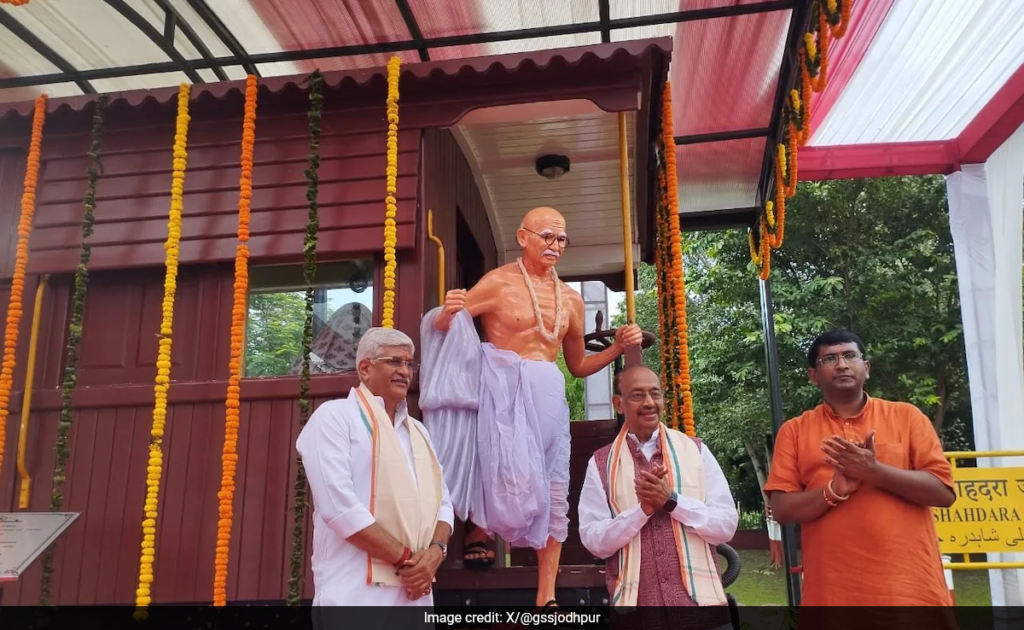Introduction: Mahatma Gandhi Railway Coach
On September 11, 2024, a momentous event took place at Rajghat, New Delhi, with the unveiling of a restored railway coach dedicated to Mahatma Gandhi, The Mahatma Gandhi Railway Coach This significant exhibit at Gandhi Darshan commemorates Gandhi’s enduring legacy and his pivotal train journeys that played a crucial role in India’s independence movement. The coach, a symbol of his commitment to connecting with the masses, now serves as a historical and educational artifact, reflecting the simplicity and profound impact of Gandhi’s travels.

Historical Significance of the Restored Railway Coach
The newly unveiled railway coach is a faithful reproduction of the third-class compartments that Mahatma Gandhi used during his extensive travels across India. Painted in a historically accurate brown hue, the coach features a ‘III’ marker, highlighting the class of travel Gandhi chose to experience the life of ordinary Indians. This meticulous restoration, a collaboration between the Ministry of Railways and cultural preservationists, ensures that the Mahatma Gandhi Railway Coach retains its historical authenticity.
Gandhi’s choice to travel in third-class compartments rather than more luxurious options was symbolic of his dedication to understanding and addressing the conditions faced by the common people. His train journeys were instrumental in shaping his political and social philosophies, which emphasized truth, non-violence, and unity.
The Impact of Gandhi’s Train Journeys
Gandhi’s train journeys across India were not merely about transportation but were a profound part of his strategy to unite the country. These journeys allowed him to interact with people from various backgrounds, gaining insights into their struggles and forging connections that strengthened his advocacy for social justice and equality. By traveling in third-class compartments, Gandhi experienced firsthand the hardships faced by ordinary citizens, which informed his approach to the independence movement and his vision for a unified India.
The railways were more than just a mode of transport for Gandhi; they were a conduit for his message of non-violence and unity. His interactions with fellow passengers and his observations during these journeys played a critical role in shaping his understanding of India’s socio-political landscape and refining his strategies for the independence struggle.
Immersive Experience at Gandhi Darshan
The exhibit at Gandhi Darshan offers visitors an immersive experience that brings Gandhi’s railway journeys to life. Inside the restored coach, detailed sculptures depict scenes from Gandhi’s travels, illustrating his interactions with passengers and the societal conditions of his time. The exhibit is designed to engage visitors through multimedia presentations and historical documents, providing a comprehensive understanding of Gandhi’s philosophy and his impact on India’s freedom struggle.
This interactive display aims to educate and inspire visitors by showcasing the significance of Gandhi’s travels and their influence on his leadership and the independence movement.
Expert Opinions on the Historical and Cultural Impact
To provide a well-rounded perspective on the significance of the exhibit, we consulted with leading experts in Indian history and cultural studies:
Dr. Anil Kumar, Historian: “The restoration of this railway coach is an important contribution to preserving our historical heritage. It not only captures the physical essence of Gandhi’s travels but also symbolizes his dedication to social justice and unity. This exhibit offers a valuable opportunity for people to connect with Gandhi’s legacy.”
Ms. Priya Sharma, Cultural Analyst: “The unveiling of the railway coach is a remarkable tribute to Gandhi’s influence. The exhibit’s attention to detail and its interactive elements highlight the relevance of his principles in contemporary times. Engaging with this piece of history is crucial for understanding the depth of Gandhi’s impact on our nation.”
Timeline of Significant Events
- 1915: Mahatma Gandhi returns to India from South Africa, beginning his influential role in the Indian independence movement.
- 1920-1940s: Gandhi undertakes numerous train journeys across India, advocating for social and political reforms.
- 1947: India gains independence, largely influenced by Gandhi’s leadership and philosophy.
- 2024: The restored railway Mahatma Gandhi Railway Coach is unveiled at Gandhi Darshan, Rajghat, as a tribute to Gandhi’s legacy and a historical educational tool.
Conclusion
The unveiling of the Mahatma Gandhi Railway Coach at Rajghat serves as a poignant reminder of Mahatma Gandhi’s enduring legacy. This meticulously restored exhibit provides a tangible connection to Gandhi’s travels and his profound impact on India’s history. By offering an immersive experience that brings Gandhi’s railway journeys to life, the exhibit ensures that his contributions to India’s independence and his vision for a just society continue to inspire future generations.
For Regular News and Updates Follow – Sentinel eGazette
FAQs
1. What is the significance of the railway coach unveiled at Rajghat? The railway coach symbolizes Mahatma Gandhi’s dedication to experiencing the lives of ordinary Indians and his commitment to social justice. It provides an authentic representation of the third-class compartments he traveled in during his mission to unite India.
2. Who was involved in the restoration of the railway coach? The restoration was a collaborative effort between the Ministry of Railways and cultural preservation experts, aimed at ensuring historical accuracy and educational value.
3. How does the exhibit at Gandhi Darshan enhance the visitor experience? The exhibit features detailed sculptures and multimedia presentations that recreate Gandhi’s train journeys, offering an immersive experience that educates visitors about his philosophy and impact.
4. When did Gandhi begin his influential train journeys across India? Gandhi’s significant train journeys began in the 1920s and continued through the 1940s, during which he advocated for various social and political reforms.
5. How does the exhibit contribute to understanding Gandhi’s legacy? The exhibit provides a tangible connection to Gandhi’s life and philosophy, highlighting the relevance of his principles in contemporary times and offering a comprehensive view of his impact on India’s independence movement.